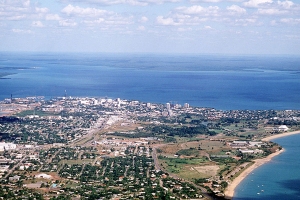Northern Territory Waste Strategy – a good first step
 The Northern Territory EPA has released its inaugural Waste Strategy. While the strategy is a great first step for the region, there is still much more to be done.
The Northern Territory EPA has released its inaugural Waste Strategy. While the strategy is a great first step for the region, there is still much more to be done.
But first, let’s talk about the context for the strategy. The NT has a number of characteristics which make it unique. It has a very a low population (243,000 people in March 2014), and low waste material generation per capita (1.32 tonnes per person and year).
Thus it has a low overall waste generation, at around 320,000 tonnes per year. This means the NT is responsible for about 0.6% of all national waste generation. Meanwhile the NT has more landfills per capita than any other jurisdiction in Australia, largely due to its scattered and sparely populated remote communities. As a result, disposal in the NT is almost exclusively to landfill, with the territory having a recovery rate of only 9%.
This makes it the “worst” performing Australian jurisdiction for recycling by a large margin but that is overly harsh. It has very specific challenges of cost and distance.
What’s in the NT Strategy?
The draft Strategy, sets a basic framework for establishing waste management systems and improving resource recovery in the region. It proposes to do this via four mechanisms:
- Engaging with stake holders;
- Improving rates of resource recovery, managing high-risk landfills and planning for future and emergency waste;
- Improving the regulatory framework; and
- Improving waste data collection.
MRA agrees with these objectives. We would make a few observations about how to achieve them.
Improving resource recovery – introduce a levy to fund infrastructure
In 2014 the NT had a population of 243,700, while Darwin had a population of 146,200, meaning 60% of the NT’s population is centralised in Darwin. This also means Darwin is Australia’s lowest performing capital city in terms of its resource recovery rates.
With a waste generation of 1.32 tonnes per person per year, implementing a $10 per tonne waste levy in Darwin could raise approximately $1.9 million per year. This funding could be invested into resource recovery infrastructure. The levy could equally be applied across all of the NT and generate further revenue however this is a decision for government.
With a disposal cost at Shoal Bay Landfill (Darwin) at $80 per tonne for commercial waste, a $10 levy would represent a 12.5% increase in costs at the gate or about 0.1% of local business costs.
Focus on organics, not kerbside recycling
While households love kerbside recycling, delivering kerbside recycling across the expansive geography of the NT may not be desirable. Darwin yes, but not the rest of the NT.
Due to the low density of recyclables such as plastic containers and paper, transporting these commodities to MRFs and markets will likely be neither economically or environmentally beneficial.
Further, kerbside recyclables represent just 17% of an average household’s waste generation. Over 60% is organic waste. So in remote areas it is better to focus on local, small scale composting operations for 60% of the stream, rather than recyclables for only 17%.
We would recommend that paper and cardboard also be composted in these remote communities, increasing the overall potential household recycling rate to 68%.
Improving landfill performance
As previously mentioned, the Northern Territory has more landfills per capita than any other Australian jurisdiction. It has been MRA’s experience in other regional areas of Australia, that small landfills can often be consolidated into a single regional landfill with transfer stations, whilst maintaining access to services and sanitation.
This is because transporting waste over relatively large distances is often much cheaper than the cost of operating, remediating and monitoring many small landfill sites. This approach also reduces environmental harm.
MRA recently reviewed 20 landfills in regional Australia. Of those 18 would save money today by conversion to transfer stations (at a cost of $70,000 to $100,000 per transfer station) including the gate fee costs at the regional landfill.
Target landfills for consolidation are those that have:
- Small tonnages;
- Are nearing end of life;
- High operational cost $/t; and
- Have a low environmental performance.
Such sites could be identified via a regional infrastructure assessment. Funds liberated from the closure of small landfills and generated via a levy could be used to improve the environmental performance of regional landfills whilst reducing the number of small landfills in the NT.



